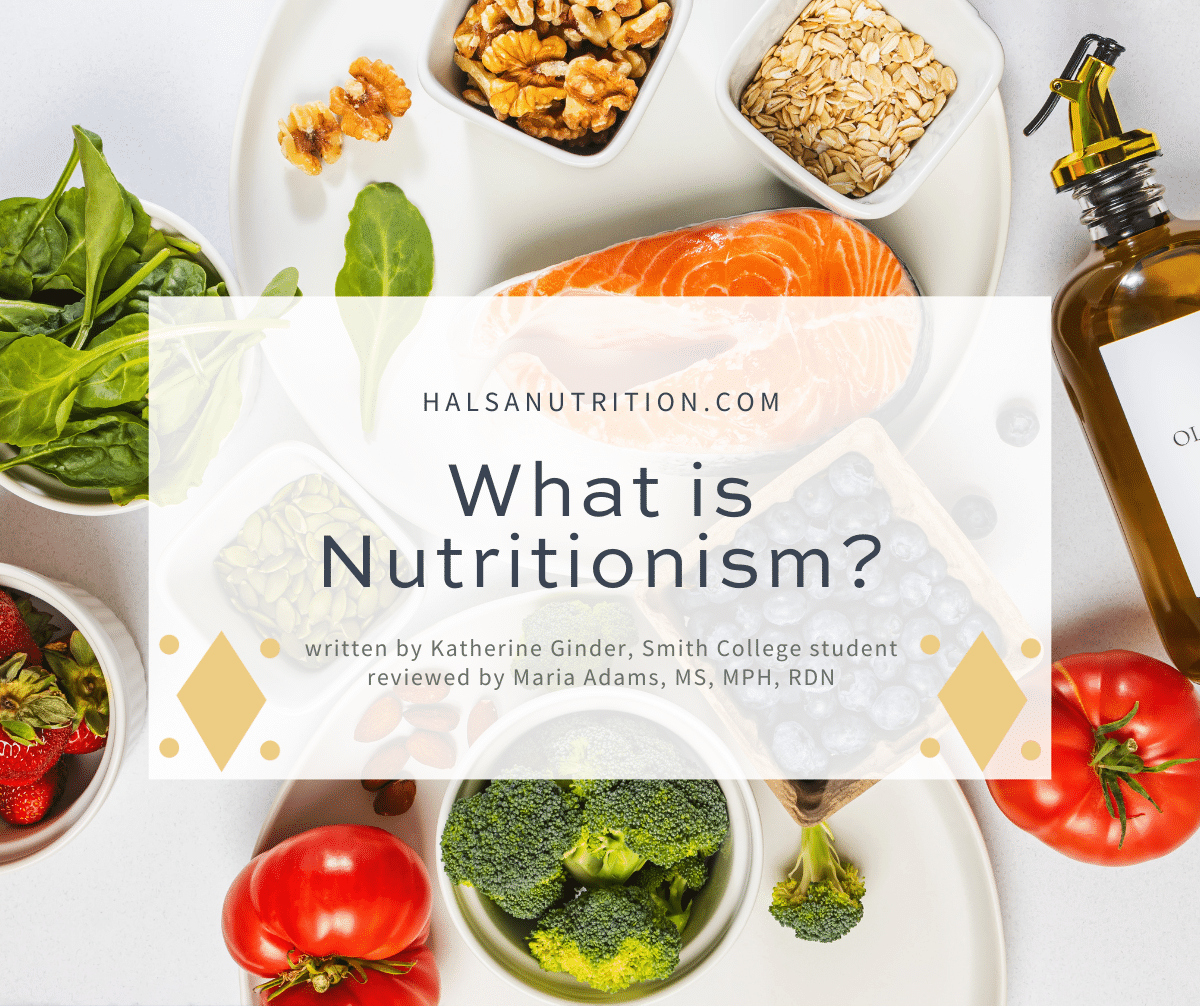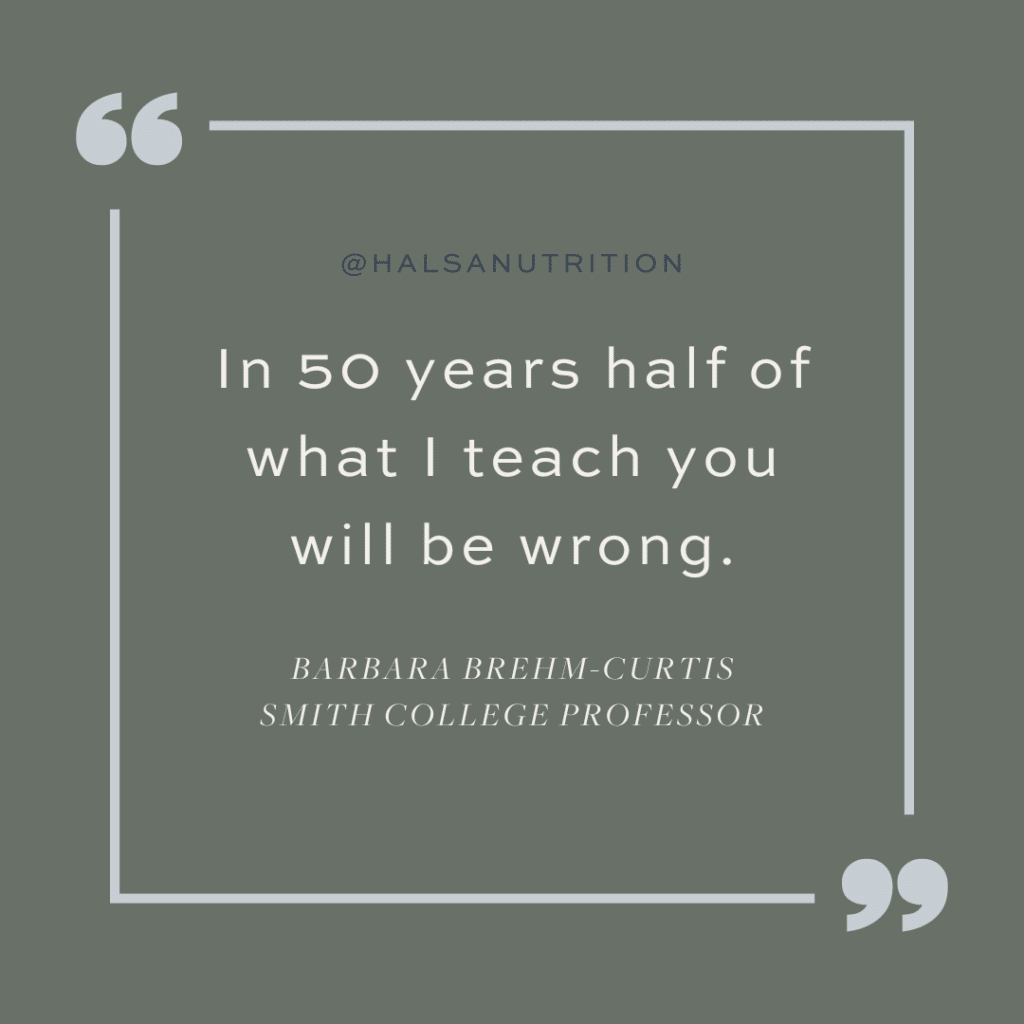
What is Nutritionism?
Estimated reading time: 5 minutes
“Is this gluten-free?”
“Is this sugar-free?“
Whether dining out with others or from the comfort of your own kitchen, you often hear people talking about what’s inside their food. Eating is a large part of American culture, but what may not be apparent is that grabbing an item because it has “gluten-free” written on the package or taking a shot of apple cider vinegar in the morning may not be ideal for you–and may not even be based on nutrition science.
What is Nutritionism?
“Nutritionism” is our society’s relatively new emphasis on what’s inside food. Nutritionism is an ideology that began in the 1980s when the focus of food shifted from the item to the individual nutrients within the food (Pollan). Michel Pollan, journalist and author of numerous books including The Omnivore’s Dilemma and In Defense of Food, describes an ideology as “ways of organizing large swaths of life and experience under a set of shared but unexamined assumptions.” The new focus on what is in our food has led to the rise of so-called superfoods.
The Food Industry
In American food culture assumptions come from many different sources. The largest being the food industry. According to the USDA, the food industry, including restaurants and food retailers, was worth $1.77 trillion in 2019 (Zeballos). Companies like Nestle and PepsiCo have considerable incentives to promote their food using catchphrases like “good for heart health” to help sell their product even if their information is not entirely accurate. Additionally, with social media, everyone from influencers, to wellness experts, to diet companies has a platform to share their beliefs on what people should or should not be eating.
Nutritionism brings the focus of food to the micro-level. One of the problems with this approach is that it becomes hard to distinguish between processed and unprocessed food. For example, a snack-size Rice Krispy Treat has 7 grams of sugar. In contrast, an apple has about 20 grams of sugar (“Food Data”). Does this mean that a Rice Krispy treat is better for you? Looking at one nutrient in a food misses the larger picture of what that food can do for your body.
Faulty Science
On my first day of nutrition this past semester, my teacher told us, “in 50 years half of what I tell you will no longer be true.” I sat there dumbfounded because in what college class does the professor tell you that half of the content taught may not be factually correct? The reason is that the study of what chemically makes up food is a young science. What we think of as nutritional science today started less than 100 years ago when the first vitamin was discovered in 1926 (Mozaffarian).
Science, in general, is constant testing of current and future discoveries, there is so much we do not know now that we will know in the future, so it is important to keep testing for these to be revealed to us and we can advance our knowledge as time goes on. Who knows what we will find out in the future and what impact it will have on what we know now.

In addition, it is hard to perform quality studies on a person eating a specific type of food. A double-blind study, when neither the researcher nor the subject knows who is in the control or treatment group, is hard to do when someone can identify a food by taste. Moreover, other types of nutrition research relies on people remembering what, how much, and when they ate–and reporting it honestly. Plus you have to control for other lifestyle factors, such as exercise, smoking, alcohol, and stress. If you compound how young science is and how hard it can be to get reliable research, it is not surprising how much misinformation around food is out there.
Drawbacks of Nutritionism
Nutritionism also has many physiological drawbacks, such as taking the joy out of eating. When food is thought of as “good,” it creates an outgroup of “bad” foods (Sturtevant). This lends itself to creating fad diets. Ideologies like low-carb and low-sugar do not have strong evidence to support their claimed health benefits, yet are accepted as “healthy” choices for people.
Another downside is the emphasis on healthful eating can cause eating paralysis: it becomes hard to decide what to eat when you spend too much time thinking about it. When this happens regularly it is known as orthorexia, an eating disorder that occurs when someone is obsessed with healthy or righteous eating.
What to do?
It’s important to realize that there is a lot of misinformation around food. With technology, many people have the platform to spread their beliefs even if they are not backed up by scientific evidence. When you hear about new trends, try to think critically about the source of this information and if it is credible before deciding to believe it. A large component of eating is pleasure which can not be measured in a nutrient amount.
Take-Aways
- Be critical of the source of your food information.
- Nutrition is a young science with many limitations regarding accurate research.
- Don’t label food as “good” or “bad.”
- Remember to enjoy eating!
Related Posts You Might Like
- The Problem with “Clean Eating”
- The Joy of Food: Why Eating for Health Isn’t Always the Most Important Thing
- Diet Culture and How to Spot it
- An Intuitive Eating Plate and Other Plate Models
About the Author
This post was first written in July 2022 by Hälsa Nutrition intern, Kate Ginder. In addition to having a passion for nutrition and food sustainability, Kate is a student at Smith College in Northampton, MA where she is an Economics major with a minor in Exercise and Sports Studies.
Post Updated: April 2024
References
- “Food Data Central Search Results.” FoodData Central, United States Department of Agriculture, 2020.
- Mozaffarian, Dariush, et al. “History of Modern Nutrition Science-Implications for Current Research, Dietary Guidelines, and Food Policy.” The BMJ, British Medical Journal Publishing Group, 13 June 2018.
- Pollan, Michael. “Unhappy Meals.” The New York Times, The New York Times, 28 Jan. 2007.
- Sturtevant, Dana, and Hilary Kinavey. “Nutritionism.” Be Nourished, 30 June 2019.
- Zeballos, Eliana. “Market Segments.” USDA ERS – Market Segments, 4 June 2020.
Leave a Reply